- Rinse chicken drum sticks in cold water and de-done meat with a sharp knife. Cut into 4 even pieces per leg drum -OR- rinse chicken breasts in cold water and cut into bite-size pieces
- In a large bowl, mix chicken with soy sauce, sugar, mul yut (substitution honey), cheong ju and ground pepper.
- Marinate in refrigerator for 30 minutes.
- Puree all marinating sauce ingredients together in a blender. Once completed, leave aside for later use.
- On a non-stick frying pan or skillet, cook prepared chicken over medium heat until meat is just short of desired completion.
- Take out chicken only and leave excess ingredients in frying pan or skillet.
- In a large bowl, thoroughly mix chicken with blended sauce from steps 2 & 3.
- In the same frying pan or skillet, add olive oil to taste and cook for an additional 3-4 minutes in medium high heat.
- Serve hot on plate.
|
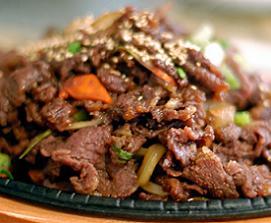 | |
|
BUL-GO-GI
Grilled Marinated Beef
불고기
|
|
Bulgogi is one of Korea's most popular beef dishes that is made from thinly sliced sirloin or another prime cut of beef (rib eye). It is usually marinated in a mixture of soy sauce, sesame oil, black pepper, garlic, onions, ginger, and sugar for two to four hours to enhance the flavor and its tenderization. Bulgogi is traditionally grilled but broiling or pan-cooking is common as well. Whole cloves of garlic, sliced onions, and chopped green peppers are often grilled or cooked at the same time. It is often served to non-Koreans as a first taste of Korean cuisine.
This dish is usually served with a side of lettuce, spinach, or other leafy vegetable, which is used to wrap a slice of cooked meat, often times along with a dab of ssamjang, kimchi, or other side dishes, and then eaten as a whole.
Korean 101: Bul is the Korean word for fire and gogi is meat, therefore, it translates into fire meat. However, it's not quite spicy in taste but somewhat on the sweet side.
|
- 1 lb thinly sliced beef (sirloin or rib eye)
- 5 tbsp sugar
- ½ cup soy sauce
- 2 buds finely chopped garlic (can be crushed but remove buds before serving)
- ¼ tsp salt
- 5 tbsp Mirin (sweet sake, optional)
- 2 tbsp sesame oil
- 2 tbsp toasted sesame seeds
- 1 cup split green onions
- 2 cups thinly sliced carrots (optional)
|
- Mix all ingredients except carrots. Marinate in refrigerator for at least 2 hours.
- Cook over medium high heat until meat is just short of desired completion.
- Add carrots and cook for an additional 3 minutes.
- Serve with rice.
|
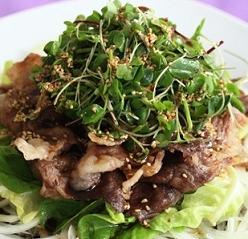 | |
|
CHA-DOL BA-KI
Sliced Beef Brisket
차돌박이
|
|
Chadol baki is a thinly sliced beef brisket meal that is also popular at homes or at Korean restaurants. The meat is not marinated whatsoever and it’s simply cooked on portable or built-in gas or charcoal grills. The meat is usually fattier than other parts of the beef, yet it’s thin enough that each slice doesn’t contain too much fat. And because of its thinness, each slice cooks very fast over open grills for quick bite after bites. Cooked chadol baki can be dipped in a sauce made up of sesame oil, salt, and pepper and eaten together with shredded scallion salad ( pa muchim). Additionally, lettuce, spinach, or other leafy vegetable(s) can be used to wrap to all contents altogether along with a dab of dwenjang or ssamjang.
Fresh packages of chadol baki meat can be purchase at Korean supermarkets or local meat markets. Pa muchim is also available for purchase but can be easily prepared at home.
|
| RECIPE INGREDIENTS: PA MUCHIM |
- 4 bunches scallions
- 2 tbsp sesame oil
- 2 tbsp rice vinegar
- 1 tsp gochugaru (red chili pepper flakes)
- ¼ tsp salt
- 1 head green leaf lettuce
|
- Cut scallion pieces lengthwise into very thin strips and also leaf lettuce into thin, mouth-sized pieces.
- Whisk sesame oil, vinegar, red chili pepper flakes and salt in a large bowl.
- Add scallions and lettuce to the bowl and toss well to combine.
|
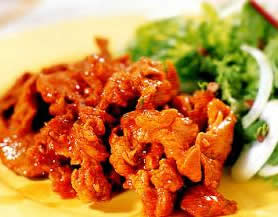 | |
|
DAE-JI BUL-GO-GI
Spicy Marinated Pork
돼지불고기
|
|
Daeji bulgogi is another popular Korean meat dish similar to bulgogi. However, instead of using beef, thin sliced pork loin is marinated in a specially blended red chili pepper paste with various assortments of vegetables. The meat is marinated with a mixture of soy sauce, sesame oil, garlic, sugar, ginger roots, rice wine and gochujang which is the base sauce for this dish. It is marinated for 30-60 minutes to bring out the depth and intensity of flavors.
Daeji bulgogi can be grilled or pan-cooked and it is usually served with a side of lettuce, spinach, or other leafy vegetable, which is used to wrap a slice of cooked meat. It is often times wrapped along with a dab of ssamjang, kimchi, or other side dishes, and then eaten as a whole. To see a visual illustration, click here.
Korean 101: Daeji means pork in Korean and bulgogi is the word for fire meat, therefore, it translates into pork fire meat. Since gochujang is the base sauce to this dish, it can get spicy in taste.
|
- 1 lb thinly sliced pork (lean & boneless preferred)
- 3 tbsp soy sauce
- 2 tbsp crushed garlic
- ½ tbsp crushed ginger root
- 2 tbsp brown sugar
- 2 tbsp gochujang (red chili pepper paste)
- 1 tsp red pepper flakes
- 2 tbsp rice wine (sake)
- 2 tbsp sesame oil
- 1 onion
|
- Combine all the ingredients except pork to make its base marinating sauce. Stir in a large mixing bowl.
- Add the pork and marinate for 30-60 minutes.
- Grill or pan-fry and serve with steamed rice.
|
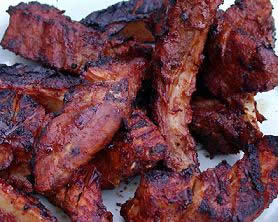 | |
|
E-JI GAL-BI
Grilled Pork Ribs
돼지갈비
|
|
Daeji galbi is Korea's finest grilled spareribs (usually pork) that are succulent in taste as well as appealing to the eyes. Daeji galbi is much close to barbecued, L.A. style, galbi ribs which are crisply grilled to perfection with its tenderloins and bones still attached. However, daeji galbi tends to be quite spicy in taste as gochujang (red chili pepper paste) is added to the base of this marinade sauce.
To complement this meal, most restaurants serve a wonderful variety of traditional side courses (banchan) consisting of mostly vegetables in various sauces, marinades and broths. A traditional side dish such as kimchi and/or kkaktugi are usually served while eating this meal. Daeji galbi is usually cooked at tables by waiter or waitress who wanders from grill to grill, turning the meat over and letting you know when the meat is ready.
Korean 101: Daeji means pork in Korean and galbi is the word for spareribs, therefore, it translates into pork spareribs.
|
- 5 lbs spareribs (pork)
- 1 (1 inch) piece ginger root, minced
- 2 onions (pureed)
- 4 tbsp minced garlic
- 1 cup gochujang
- 4 tbsp sugar
- 2 tbsp soy sauce
- 3 tbsp sesame oil
- 1 tsp black pepper
|
- If ribs are not separated, separate by cutting meat between the bones. Place in a large bowl.
- Purée onions in a blender as it is easier to marinade and spread on ribs.
- Combine all ingredients except pork ribs.
- Once ingredients are all mixed consistently, rub marinade generously over meat.
- Cover and refrigerate 5 hours or preferably overnight.
- Grill ribs over medium-high heat until done, about 8-10 minutes per side.
- If cooked in an oven, preheat to 350º. Spray cooking spray onto a baking sheet and place the ribs on it. Cook for 1 hour and 45 minutes or until the meat is so soft that it falls off the bone.
|
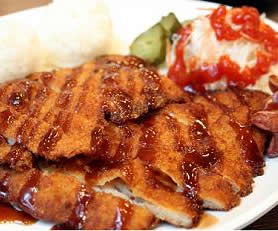 | |
|
DON-KA-TSU
Breaded Pork Cutlet
돈까스
|
|
Donkatsu is originally a Japanese dish that was first introduced in the late 19th century but it's now commonly found in Korean restaurants everywhere. It’s a popular Asian dish that consists of breaded, deep-fried pork cutlet one to two centimeters thick and sliced into bite-sized pieces. It is generally served with bop (steam white rice), vegetables such as broccoli, radish, shredded cabbage and/or miso soup.
Either pork fillet or pork loin cut may be used and the meat is usually salted, peppered and dipped in a mixture of flour, beaten egg and panko (Japanese breadcrumbs) before being deep fried. Regardless of the presentation, donkatsu is most commonly eaten with a type of thick Japanese Worcestershire sauce that uses puréed apples as a principal ingredient. Different variation of donkatsu exists which chicken or beef can be used as an alternative to pork.
|
- 4 boneless pork chops, ½ inch thick
- 2 tablespoons flour
- 1 beaten egg
- ½ cup of panko (Japanese bread crumbs)
- Vegetable oil (for frying)
- Salt & pepper
|
- Pound pork to ¼ inch thickness.
- Coat with flour, then dip into egg, and finally coat thoroughly with Panko.
- Deep fry in 1 inch vegetable oil, heated to 350º, 3 minutes on each side, or until golden brown.
- Serve with rice, vegetables and/or miso soup.
|
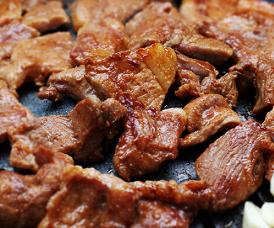 | |
|
GAL-BI
Grilled Beef Short Ribs
갈비
|
|
Galbi is a very popular Korean meat dish made from beef short ribs. The ribs are marinated in a sauce made from Korean pear juice, rice wine, soy sauce, garlic, sesame seed oil and sugar. Most recipes contain these basic ingredients but many variations exists from sweet to spicier marinades.
The meat itself is often cut in the L.A. rib style, which is basically a rack of ribs cut in thin slices across the bones. This makes eating galbi easier with chopsticks or with fingers. Galbi is usually available in most Korean restaurants but it is generally served in venues that specialize in galbi and the meat is cooked on an in-table BBQ.
This dish is usually served with a side of lettuce, spinach, or other leafy vegetable, which is used to wrap a slice of cooked meat, often times along with a dab of ssamjang, kimchi, or other side dishes, and then eaten as a whole. To see a visual illustration, click here. Galbi itself means rib in Korean and there are many dishes that incorporate galbi to make soups and stews such as galbitang and galbijim. |
- 16 ribs
- 1 cup soy sauce
- ¾ cup sugar
- ½ cup water
- 1 Asian pear, chopped (or ½ Korean pear)
- 1 onion, chopped
- 2 tbsp minced garlic
- 4 tbsp sesame oil
- 1 tbsp ground pepper
- 1 tbsp juice of ginger
|
- Wash meat. Rarely but sometimes you can find tiny bone scraps stick to the meat. Soak in water for 1 hour, drain.
- In a food processor, add chopped onion and pear, purée finely. Pour out to a large bowl, add remaining ingredients and stir.
- Marinate beef for 8-10 hours or overnight for optimal taste. They cook fairly fast, 2-3 minutes on one side.
- Traditionally, it is grilled with a wood charcoal but certainly you can grill on a gas stove or outdoor grill.
|
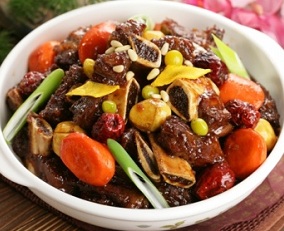 | |
|
GAL-BI-JIM
Braised Beef Short Rib Casserole
갈비찜
|
|
Galbijim is a popular Korean casserole dish made with galbi, generally from beef short ribs and a definite crowd-pleaser whether it's eaten at a restaurant or served at home. It's commonly served as the main dish but leftovers or smaller portions can be served as a side dish as well. During preparation, surplus fat is removed from the ribs by cutting and removing after parboiling. Soy sauce, sesame oil, scallions, minced garlic, pepper, ginger juice, and sugar are mixed together with ribs and slowly simmered in a large pot over medium to low heat to enhance its tender and sweet finish.
When the meat is almost cooked, jujube, ginkgo nuts, carrots, and/or pine nuts are be added and boiled once again. Chestnuts and shitake mushrooms can be also added near the end to bring out extra flavors to this dish. Galbijjim is usually served in a bowl rather than a plate and traditionally served in a bowl with cover.
|
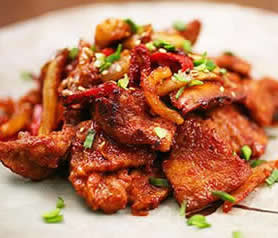 | |
|
JAE-YOOK
(KIM-CHI) BO-KUM
Spicy Pork And Kimchi Stirfry
제육(김치)볶음
|
|
Jayook bokum also known as jaeyook kimchi bokum, is a delicious Korean dish that consists of marinated pork loin which are stir-fried with kimchi and red chili pepper paste, gochujang. When making jaeyook bokum, gochujang is the key base sauce to this dish which determines the flavor and its level of spiciness. Depending on one's taste, spiciness can be softened by adding more soy sauce and less gochujang and red chili powder to the sauce mix.
Jayook bokum can also be prepared with thinly sliced pork belly strips, much like what's found in samgyupsal. Tofu is a great addition commonly found alongside this dish but it is sometimes eaten with a bowl of steamed, white rice to compliment its spiciness. Pork meat are initially cooked over a medium to high heat and then stirred fried with gochujang, kimchi, onions, carrots, scallions and other optional vegetables.
Some prefer pork to be crispy and bacon-like prior to stir-frying all ingredients together. Jayook bokum is popular as an appetizer while drinking soju but also great and hearty as a meal with rice and many other side dishes. |
| RECIPE INGREDIENTS: SAUCE |
- 1-4 tbsp gochujang
- 1-4 tbsp soy sauce
- 1 tbsp garlic (minced)
- 1 tbsp sesame oil
- 1 tbsp ginger juice (or powder)
- 3 tbsp sugar
- Black ground pepper to taste
- 1 tbsp red pepper flakes (optional)
- 1 package of firm tofu (optional)
|
- 20 oz. pork loin or belly
- ½-1 cup kimchi, bite sized
- 1 onion
- 2 stalks green onions
- ½ carrot
- 1 bell pepper (optional)
- 2 jalapeño peppers (optional)
|
- In a bowl, add 1-4 tbsps of gochujang depending on how you want your level of spiciness. Make up any difference with 1-4 tbsps of soy sauce. For example, if you prefer a mild taste, add 2 tbsps of gochujang and 2 tbsps of soy sauce but the total combination should not be more than 4 tbsps.
- Add sesame oil, minced garlic, ginger juice or powder, sugar and pinch of black ground pepper.
- If desired, add 2 tbsps of red pepper flakes to make it spicier.
- Mix all ingredients well and put aside for later use.
- For pork loins, use a meat tenderizer and lightly beat on meat until they are become very thin. Cut into desired, bite sized pieces thereafter. For pork bellies, cut thin strips into bite size pieces.
- Add pork meat to the bowl of sauce that was prepared earlier and thoroughly marinate meat. Optimal time for meat to marinate is 30 minutes -- put aside to prepare vegetables.
- Cut onion and carrot into thin strips, and cut green onion diagonally. Bell pepper and jalapeños are optional.
- In a large pan, stir-fry pork for about 4-5 minutes in med-high heat.
- Add kimchi along with vegetables into mix. Cook until pork is thoroughly cooked.
- To prepare tofu, boil water in pot and add entire block of tofu for 3-5 minutes in hot water. Rinse with cool water and cut them into smaller, bite-sized "blocks."
- Place pork and kimchi stirfry in middle of plate and garnish with tofu around the plate.
|
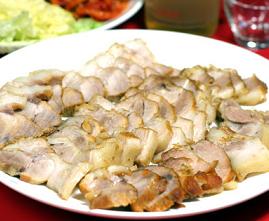 | |
|
JOK-BAL
Seasoned Pork Trotter
족발
|
|
Jokbal is a very popular pork dish to many Koreans worldwide. In translation, it means pig’s trotters or legs (boneless) which have been seasoned and steamed. It may sound strange and unappealing to foreigners, but anyone who has once tried jokbal will get into the charm of this delicate dish. The pork is spiced with black taffy, soybean sauce and ginger which give its irresistible taste of the meat.
The secret of its popularity is the broth in which the jokbal is cooked as it is seasoned and simmered for about 2 to 3 hours. The steam rises from the pot until the mouth-watering meat is cooked to perfection. The secret of the delicious meaty flavor lies in the rich broth, and to this day, every restaurant’s broth recipe is considered top secret.
Almost all restaurants will serve the same condiments and side dishes to go along with jokbal. Various side dishes include lettuce, mul kimchi, kimchi, shredded radish, and buchu (Korean leek). And usual condiments include ssamjang (mixture of pepper and fermented bean paste) and salted shrimps for dipping. For consumption, jokbal can be wrapped in lettuce leaves along with some of the side dish or condiment to fully enjoy this meal. To see a visual illustration, click here.
Fact: Soju is widely known to be consumed while eating jokbal.
|
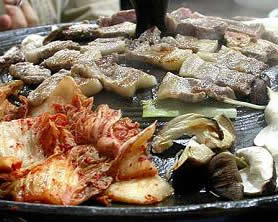 | |
|
SAM-GYUP-SAL
Grilled Pork Strips
삼겹살
|
|
Samgyupsal is another popular Korean meat dish that are enjoyed at home or at Korean resaturants that specializes in meat dishes. It consists of thick pork strips, served in the same fashion as galbi but there is no marinating involved. It is usually cooked on a grill with pa muchim, kimchi, mushrooms, garlic, onions and consumed altogether.
This dish is usually served with a side of lettuce, spinach, or other leafy vegetable(s), which is used to wrap a slice of cooked samgyupsal. A dab of ssamjang (usually made of gochujang or dwenjang), kimchi, or other side dishes are also added and then eaten as a whole. To see a visual illustration, click here.
|
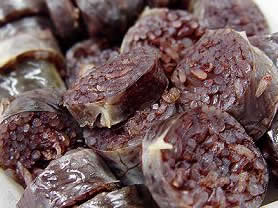 | |
|
SOON-DAE
Pork Sausage
순대
|
|
Soondae is a pork sausage, filled with mixed with sweet rice and sweet potato vermicelli noodles. It is a traditional Korean sausage and popular snack food sold by various restaurants as well as street vendors. Unlike meaty American or European sausages, soondae is lightly spicy in taste and steamed to a moist, soft roll which is then cut into oval slices. It has great texture and guaranteed to melt in one’s mouth. A mixture of salt, ground pepper and gochugaru (red chili pepper flakes) is served alongside this dish for flavoring. Soondae is usually served with kimchi like cubed radish, kkakdugi, along with a warm miso-type soup or udon.
|
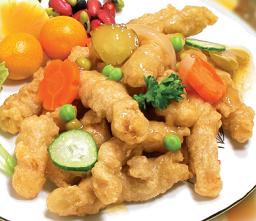 | |
|
TANG-SU-YUK
Sweet & Sour Pork Or Beef With Vegetables
탕수육
|
|
Tangsuyuk is another popular Chinese delicacy in Korea, which is more familiarly known to Westerners as sweet and sour pork/beef with vegetables. This dish is more of a crowd-pleaser, consisting of a pile of battered, crispy fried pork or beef strips in a sweet, tart apple & vinegar based sauce.
The dish is also laced with pickled snippets of cucumber, carrot, and sometimes cubed pineapples that offer a variety of color as well as taste. It is usually eaten as an appetizer, ample enough for a quartet of diners to share. When eating, the meat is usually dipped in soy sauce mixed with vinegar and crushed or powder red pepper flakes ( gochugaru) which will add some spiciness to each bite. |
| RECIPE INGREDIENTS: SAUCE |
- 1½ cup water
- ½ tbsp soy sauce
- 2 tbsp rice vinegar
- 5 tbsp sugar
- ¼ tsp salt
|
- 12 oz pork or beef (lean, grilling part)
- 1 egg, lightly beaten
- ¼ onion, sliced
- ¼ carrot, sliced
- ¼ cucumber, sliced
- 1 cup corn starch
- 1 cup water
- 1 teaspoon vegetable oil
- Vegetable oil for deep-frying meat
- Salt & pepper
|
| COOKING DIRECTIONS: SAUCE |
- Mix 1 cup corn starch and 1 cup water, stir well, and let sit for 1-2 hours.
- After the corn starch and water are separated, carefully drain water.
- Heat oil in a large pot to fry. Don't fill more than a half way.
- Cut beef into thin strips, add 1/8 teaspoon salt, 1/16 teaspoon pepper and egg, mix well.
- Put meat in a corn starch batter, mix well with hands.
- Once you are done consistently coating the meat with batter, deep-fry it in oil until golden. *The key for crispy meat is to fry twice, so before serving it, fry once again.
|
- Add 1 tsp of vegetable oil to a hot pan and sauté vegetables briefly for about 1-2 minutes.
- Add sauce ingredients, stir to dissolve sugar and bring to a boil.
- In a separate bowl, mix 2 tbsp of corn starch and 2 tbsp of water to make slush.
- Then add the slush to the boiling sauce and stir until it gets thick.
- Important thing is to put corn starch mixture to the boiling sauce. The slush may not mix well if you put in lukewarm sauce.
- Continue boiling for 4-5 minutes.
- Once the sauce is complete, pour it over onto the meat and serve hot.
|
|
|
|
|
|
|
|
|
|
|
|
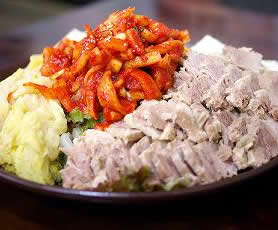













No comments:
Post a Comment